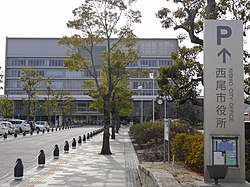Nishio, Aichi
|
Nishio 西尾市 |
|||
|---|---|---|---|
| City | |||

Nishio City hall
|
|||
|
|||
 Location of Nishio in Aichi Prefecture |
|||
| Coordinates: 34°51′42.6″N 137°03′42.5″E / 34.861833°N 137.061806°ECoordinates: 34°51′42.6″N 137°03′42.5″E / 34.861833°N 137.061806°E | |||
| Country | Japan | ||
| Region | Chūbu (Tōkai) | ||
| Prefecture | Aichi Prefecture | ||
| Government | |||
| • Mayor | Yasumasa Sakakibara (since July 2009) | ||
| Area | |||
| • Total | 161.22 km2 (62.25 sq mi) | ||
| Population (May 1, 2015) | |||
| • Total | 166,278 | ||
| • Density | 1,030/km2 (2,700/sq mi) | ||
| Time zone | Japan Standard Time (UTC+9) | ||
| - Tree | Camphor laurel | ||
| - Flower | Rose | ||
| Phone number | 0563-56-2111 | ||
| Address | 22 Yorizumichō Shimoda, Nishio-shi, Aichi-ken 445-8501 | ||
| Website | Official website | ||
Nishio (西尾市 Nishio-shi?) is a city located in Aichi Prefecture, in the Chūbu region of Japan. It is a regional commercial and manufacturing center and the country's leading producer of powdered green tea.
As of May 2015, the city had an estimated population of 166,278 of which some 5,800 are foreign residents. The total area was 160.22 square kilometres (61.86 sq mi) and the population density is 1,030 persons per km².
The Mikawa area has been inhabited since prehistoric times, as attested by finds of pottery shards from the Jōmon period and the megalithic Kofun tomb in Kira, the oldest in the Mikawa Province. The fertile plains along the Yahagi River have been used for rice-farming as well as the production of tea and cotton since ancient times. Shell mounds dating to the late stone age and found in what is today the town center also point to fish and seafood as important early local produce. In Hazu, a shrine from the Nara period is evidence of an early cultural connection to the Japanese capital at the time.
During the 15th century Sengoku period, Nishio was the home territory for the Sakai clan, based at Nishio Castle. The area eventually came under the control of the Tokugawa clan, and during the Edo period, most of the area was ruled as the Nishio Domain, a minor fudai feudal domain of the Tokugawa shogunate. The area prospered as a fishing port, and due to its location on the Tōkaidō highway connecting Edo with Kyoto, although the town itself suffered heavy damage due to a tsunami in the 1707 Hōei earthquake.
...
Wikipedia


